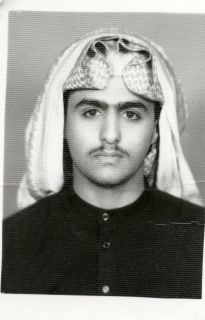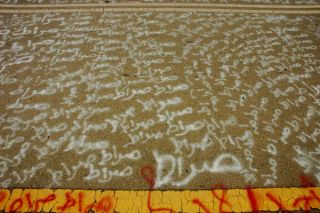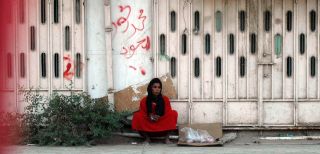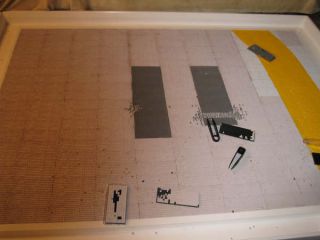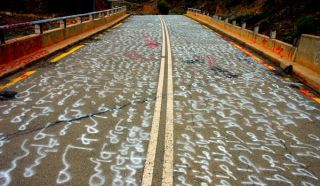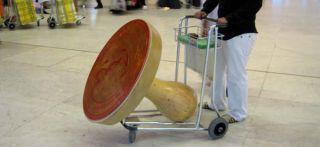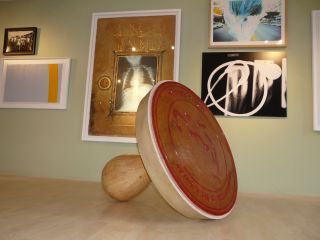|
Abdulnasser Gharem's (1973) mission is to restore behaviour to a higher standard, remembered from the past, while taking into account new technologies and insights. The artist from the town of Khamis Mushait is a luitenant-colonel of artillery (now in administration), who aims at the brains and not the bone structure of life's realities. Do not put your trust in concrete, when planning battles of the future, is what Gharem says by selecting his own ground to fire from with weapons of his choice. The training shows. The 'art people' call it performance art. People of performance might call it art of survival.
Gharem entered the field at the Sharjah 2007 biennial documenting a 'survival' performance Flora and Fauna (2006) in which he wrapped himself in plastic with a tree on a busy road in the town of Abha. He stayed in his greenhouse for several hours living of the oxygen that the tree was meant to produce. The foreign imported Conocarpus Erectus tree is much used in city landscaping in the Middle East and elsewhere, but is said to have a disastrous effect on the local tree population. Dealing directly with ecological concerns of urban planning the performance in a much broader sense may have reflected on the dangers of thoughtless adoption of foreign ideas.
'People at first thought he was crazy,' is what Gharem told Henry Hemming in an interview for the Edge of Arabia (2008) exhibition. But then they started to appreciate his operations on the roads of Saudi Arabia. 'Their minds are not closed so they came over to ask about it.' Reforming people's ideas about art away from copying Italians may be collateral damage his work inflicts.
Another maneuvre of speed and impact was in support not of flora but of Homo Erectus himself. In Manzoa (2007) Gharem moved himself around for a day and night in a so called 'unorganized residential district' from which both the residents and houses were to be removed for new development. The name of the performance is Arabic for 'removal.' It was written on the houses to announce their fate and that of their residents and the artist had it written on his shirt during the performance.
From chance of seeing a broken bridge and learning its history Gharem welded his conceptually most voluptuous work. Al-Siraat was made in the night of August 19, 2007 when the artist and his assistents covered the whole bridge with one word: al-siraat (the path). The bridge, which is in a ravine in the Tihama region, had been abandoned since it collapsed in 1982. Its tragic history is that it was used by people, trusting the concrete, as a refuge to shelter from an expected flash flood. From the idea that even concrete roads and bridges can't be trusted Gharem crossed over to associate the bridge with 'the path' in the spiritual sense of the word. 'It is about the choices you make in life, and whether or not you follow the straight path,' is what he said about it. The work was documented by photography and in a video with a touch of irony.
Al-Siraat became part of a controversy in the British press when it was reported that the work had not been included in the Edge of Arabia exhibition by a decision unclearly defined as having been taken by either a sponsor, guest curators or The School of Oriental and African Studies.
In both a visual and conceptual parallel to Al Siraat Gharem produced an alternative work of art for the exhibition intended to convey a similar message. For his Restored Behavior (2008) series the artist went on a humoristic adventure of subverting bureaucracy by buying in shops all over Saudi Arabia as many office stamps as he could find. Taking out the rubber letters and numbers, glueing them on boards and then painting over them a yellow road line he created anew an image of 'the path.' Not having yourself stamped but painting your own way over stamps is not unlike 'not trusting concrete.' In the paintings the bridge crossing the ravine was changed by Gharem into a Pedestrian Crossing. And like the bridge the crossing collapsed: the two stripes of the Zebra contained an image of the Twin Towers at the moment of impact of the second airplane. As a final salvo of his serious intentions Gharem produced an oversized and useable stamp which read in both hope and irony and in both Arabic and English: 'Have a bit of commitment, Amin.' With it were three road lights to guide you in the dark. Using science in darkness may be the concept.
His motto: 'I will'
Sources:
http://universes-in-universe.org/eng/nafas/articles/2008/abdulnasser_gharem
http://universes-in-universe.de/car/sharjah/eng/2007/tour/img-13.htm
http://www.edgeofarabia.com/artists/abdulnasser-gharem/
http://www.wheelmeout.com/issue2/index.php
http://www.wheelmeout.com/issue2/index.php
http://www.socialcohesion.co.uk/
http://www.abdulnasser-art.com/
www.abdulnassergharem.com
www.xvagallery.com
© All rights reserved | 